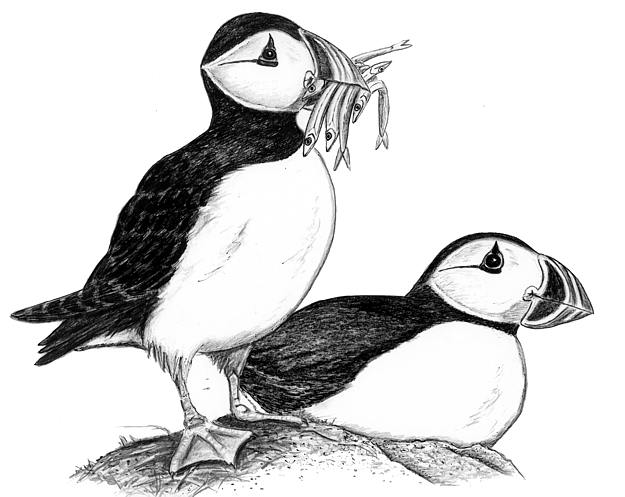
Dear Bird Folks,
Puffins are often pictured holding a mouthful of fish. The heads and tails of the fish hang out of one side of the beak or the other. My husband claims the birds always alternate the way they hang fishes’ heads and tails out of their beaks. Is this true? This may sound like a stupid question to you but this argument has been raging in our house for years. Please help.
– Donna, Boxborough, MA
You found it, Donna,
You know the expression, “there is no such thing as a stupid question”? Well, you may have found the exception. Let me get this straight. Your husband thinks that all puffins are born with a touch of OCD and will only carry fish in their mouths if they are somehow able to coordinate which way the fishes’ heads and tails are facing? Maybe I should introduce your husband to my wife. She once told me that very same thing. I couldn’t believe what I was hearing. I don’t know about your husband, but my wife is normally pretty clear-thinking. I’ve only known her to do two unintelligent things. The first was believing this puffin/fish head story; the other was marrying me. People are still shaking their heads over that one.
I’m glad you asked about puffins because they seem to be a forgotten bird. Thirty years ago, when puffin populations were struggling, they were the cover birds on every birding magazine and were constantly featured on nature shows. Today it’s hard to find a single story on puffins, unless you happen to cross the border into Maine. There the puffin craze continues unabated. Shops sell everything from puffin candy to puffin underwear. Since Maine is the only state in the country where Atlantic Puffins nest, I’m surprised they haven’t made it their state bird yet. I really wish they would switch to the puffin because right now their state bird is the Black-capped Chickadee and that’s also our state bird. I don’t like sharing it. Maine is a big state; they should get their own unique bird and leave ours alone. (The truth is, Maine chose the chickadee long before Massachusetts did, but I’m hoping they don’t know that.)
Like the Razorbills we wrote about a few weeks ago puffins are members of the auk family. But while the sedate black and white razorbills look like a flock of swimming nuns, the flamboyant puffins have these amazingly colorful faces, looking like nuns riding a Carnival float in Rio. The best places to see puffins are on their breeding colonies, which can be found on both sides of the North Atlantic. England, Ireland and Iceland all have colonies, as well as the Canadian Maritimes and the aforementioned State of Maine. Unfortunately for us, most colonies are located on isolated islands, which aren’t readily accessible. But if you happen to take a springtime trip to Ireland, swing by the Cliffs of Moher. These impressive cliffs, which rise over 700 feet above the Atlantic, are home to hundreds of nesting puffins. The cliffs are also one of the few places where puffins can be seen from land. That means people like me can see the birds without having to deal with a rocking, seasick inducing boat. In addition to seeing the birds, the views from the cliffs are spectacular, especially if it’s a clear day, which in Ireland has never happened.
A puffin’s nest is typically found in a rock crevice or in a burrow that the birds dig out with the help of their massive beaks. The females lay exactly one single egg, never more, just like the Raven says. Once the chick hatches both parents are kept very busy bringing it a steady supply of fresh fish. This is when we see adult puffins standing in the classic pose, with fish dripping of out of both sides of their mouths. The fish hang out of the beaks in whatever position they were caught and there is no rearranging to alternate the heads and tails. (Sorry, hubby dude.)
What is fascinating, however, is that the birds are somehow able to catch fish after fish without any of the fish escaping from their beaks. Think about that. If a dog picks up a stick in its mouth, it can’t pick up another stick without the first one falling out or at least getting in the way. Puffins have evolved several adaptations that help them with their fish gathering chores. The first has to do with how the beak opens and closes, which is a little too complicated to describe in print. It’s more of a show-and-tell thing, so you’ll just have to take my word for it. (When I get a PBS special, explaining these kinds things will be much easier.) Their other adaptation is much simpler to describe. The edges on the birds’ beaks have backwards-facing barbs on them. Their tongues have barbs, too. When a fish is caught, it is locked onto the beak barbs and held tight with the tongue. This allows the birds to continue grabbing fish, regardless of which way the heads are facing.
I hope this settles the raging argument you are having at home, Donna. Puffins don’t have time to worry about fish head directions. Their only concern is to survive, and of course to get a good spot on a Carnival float in Rio.